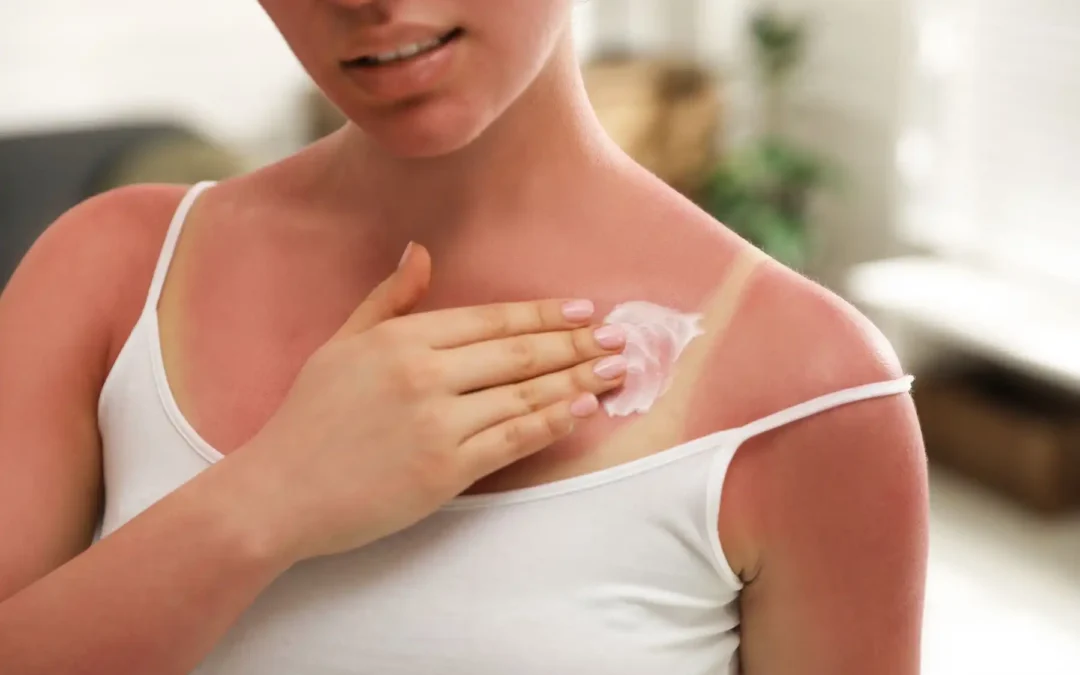Sunburn isn’t just uncomfortable – it’s a sign of skin damage that can have long-term effects. While prevention is always best, knowing the most effective treatments for sunburn can help you recover faster, reduce pain, and avoid complications such as infection or lasting pigmentation changes. In this guide, we’ll explore how to manage everything from mild redness to flaky skin from sunburn and even how to treat sunburn with blisters at home.
Recognising the Severity of Sunburn
Before deciding on the best sunburn treatment home remedy or medical approach, it’s important to assess how bad the burn is.
- Mild sunburn: Red, warm, slightly sore skin
- Moderate sunburn: More intense redness, swelling, and discomfort
- Severe sunburn: Intense pain, large blisters, fever, or chills – these require medical attention
If your sunburn is peeling heavily or blisters cover a large area, you may need more than just over-the-counter treatments.
Immediate Relief for Sunburn
When your skin is hot and painful, fast action can make a big difference.
- Cool compresses or baths – Avoid ice directly on skin, as this can cause further damage.
- Fragrance-free aloe vera gel – Soothes and hydrates without irritation. This is available to purchase at most supermarkets and health and beauty retailers like Boots and Superdrug
- Hydration – Drink plenty of water to help your skin repair itself from within.
These steps won’t reverse the burn, but they can reduce discomfort and inflammation while your skin starts to heal.
Sunburn Treatment at Home
For many people, a sunburn treatment home approach is all that’s needed. The goal is to keep the skin cool, hydrated, and protected.
- Moisturise often with a gentle, fragrance-free cream or ointment.
- Avoid hot showers as they can dry and irritate the skin further.
- Wear loose, soft clothing to prevent friction.
If your sunburn is peeling, avoid pulling at loose skin. This can increase your risk of infection and slow healing. Instead, apply a hydrating moisturiser or emollient regularly to support natural shedding.
Treating Flaky Skin from Sunburn
Flaky skin from sunburn is part of your body’s natural repair process – damaged skin cells are being replaced with new, healthy ones.
- Don’t pick or peel – Let the skin shed naturally.
- Use a barrier cream – Products with ceramides or hyaluronic acid help lock in moisture.
- Avoid exfoliation – Physical scrubs or chemical exfoliants can worsen irritation.
If the flakiness is accompanied by itchiness, an over-the-counter hydrocortisone cream (used sparingly and as directed) can help reduce inflammation.
How to Treat Sunburn with Blisters
Blisters are a sign of a second-degree sunburn, meaning deeper skin damage. If you need to treat sunburn with blisters, follow these steps:
- Do not pop the blisters – This increases infection risk.
- Cover gently with a sterile, non-stick dressing.
- Keep the area clean and avoid friction.
Seek medical advice if blisters are large, painful, or cover a wide area, as professional wound care may be needed.
Pain Relief Options
In addition to topical treatments for sunburn, pain and inflammation can be eased with:
- Over-the-counter painkillers like ibuprofen or paracetamol.
- Anti-inflammatory creams (if suitable for your skin and not used on broken skin).
Always check labels and follow usage guidelines, especially if you’re taking other medications.
When to See a Doctor
Some sunburns go beyond what can be managed with a sunburn treatment home routine. Seek urgent medical attention if you have:
- Fever, chills, or dizziness
- Severe blistering over a large area
- Signs of infection (increased redness, pus, or swelling)
Special Considerations for Lips and Scalp
Two areas often overlooked in sun protection are the lips and scalp – and they can be especially painful when burnt.
If you’re dealing with sunburn in these areas, we’ve written dedicated guides to help you:
- Treating sunburned lips – click here for gentle healing and prevention tips
- Treating a sunburned scalp – click here for soothing care for a sensitive area
Preventing Future Sunburn
While treatments for sunburn can help you recover, preventing burns in the first place is far better for your skin health.
- Use broad-spectrum SPF 30+ daily, even on cloudy days.
- Reapply every 2 hours or after swimming/sweating.
- Wear protective clothing and hats for extra coverage.
Remember – repeated sunburns increase your risk of premature ageing and skin cancer!
Long-Term Skin Care After Sunburn
Even after your skin feels better, the effects of sunburn can last. Keep up a protective and hydrating skincare routine:
- Antioxidant serums to fight free radical damage
- Daily SPF to prevent further UV harm
- Gentle cleansers to avoid stripping natural oils
This is especially important if your sunburn is peeling or you’ve experienced flaky skin from sunburn, as new skin cells are more vulnerable.
Conclusion
Knowing the right treatments for sunburn can make all the difference in how quickly and comfortably you recover. From quick relief to managing flaky skin when sunburn is peeling and understanding how to treat sunburn with blisters, the right care helps minimise long-term damage.
And while a sunburn treatment home routine can often help, prevention is key – keep your skin protected and healthy year-round.
For more targeted advice, don’t forget to check out our related guides on treating sunburned lips and treating a sunburned scalp for those tricky areas.


